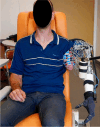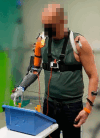Smart ArM: a customizable and versatile robotic arm prosthesis platform for Cybathlon and research
- PMID: 39103888
- PMCID: PMC11299288
- DOI: 10.1186/s12984-024-01423-9
Smart ArM: a customizable and versatile robotic arm prosthesis platform for Cybathlon and research
Abstract
Background: In the last decade, notable progress in mechatronics paved the way for a new generation of arm prostheses, expanding motor capabilities thanks to their multiple active joints. Yet, the design of control schemes for these advanced devices still poses a challenge, especially with the limited availability of command signals for higher levels of arm impairment. When addressing this challenge, current commercial devices lack versatility and customizing options to be employed as test-beds for developing novel control schemes. As a consequence, researchers resort to using lab-specific experimental apparatuses on which to deploy their innovations, such as virtual reality setups or mock prosthetic devices worn by unimpaired participants.
Methods: To meet this need for a test-bed, we developed the Smart Arm platform, a human-like, multi-articulated robotic arm that can be worn as a trans-humeral arm prosthesis. The design process followed three principles: provide a reprogrammable embedded system allowing in-depth customization of control schemes, favor easy-to-buy parts rather than custom-made components, and guarantee compatibility with industrial standards in prosthetics.
Results: The Smart ArM platform includes motorized elbow and wrist joints while being compatible with commercial prosthetic hands. Its software and electronic architecture can be easily adapted to build devices with a wide variety of sensors and actuators. This platform was employed in several experiments studying arm prosthesis control and sensory feedback. We also report our participation in Cybathlon, where our pilot with forearm agenesia successfully drives the Smart Arm prosthesis to perform activities of daily living requiring both strength and dexterity.
Conclusion: These application scenarios illustrate the versatility and adaptability of the proposed platform, for research purposes as well as outside the lab. The Smart Arm platform offers a test-bed for experimenting with prosthetic control laws and command signals, suitable for running tests in lifelike settings where impaired participants wear it as a prosthetic device. In this way, we aim at bridging a critical gap in the field of upper limb prosthetics: the need for realistic, ecological test conditions to assess the actual benefit of a technological innovation for the end-users.
Keywords: Arm prosthesis; Cybathlon; Rehabilitation engineering; Research test-bed; Robotic arm.
© 2024. The Author(s).
Conflict of interest statement
The authors declare no competing interest related to the work presented in this paper.
Figures
















References
-
- Johannes MS, Faulring EL, Katyal KD, Para MP, Helder JB, Makhlin A, et al. The modular prosthetic limb. In: Wearable robotics. Elsevier; 2020. pp. 393–444.
-
- Bennett DA, Mitchell JE, Truex D, Goldfarb M. Design of a myoelectric transhumeral prosthesis. IEEE/ASME Trans Mechatron. 2016;21(4):1868–79.10.1109/TMECH.2016.2552999 - DOI
-
- Kyberd PJ, Poulton AS, Sandsjö L, Jönsson S, Jones B, Gow D. The ToMPAW modular prosthesis: a platform for research in upper-limb prosthetics. J Prosthet Orthot.. 2007;19(1):15–21.10.1097/JPO.0b013e31802d46f8 - DOI
Publication types
MeSH terms
Grants and funding
LinkOut - more resources
Full Text Sources
Medical
Research Materials
Miscellaneous

